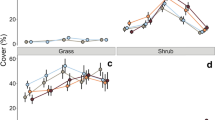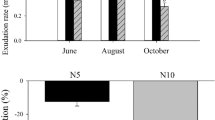Abstract
Background and aims
Variations in responses to soil N between a non-N-fixing shrub, Baccharis halimifolia L., and a N-fixing shrub, Morella cerifera (L.) Small, were tested over 12 weeks to determine whether N availability is the sole cause of persistent dominance of M. cerifera on barrier islands.
Methods
Plants were supplied increasing levels of soil N up to 200 mg kg−1. Measurements included gas exchange and chlorophyll fluorescence parameters across treatments, species, and time. Tissues were analyzed for differences in biomass and nutrients.
Results
Baccharis halimifolia had reduced physiological responses across all treatment levels, but M. cerifera had comparatively few variations. Across all treatments B. halimifolia photosynthesis and stomatal conductance were reduced by 62 and 76 %, respectively,by week 12. Increasing foliar δ15N values across treatments for M. cerifera indicated a shift from utilizing fixed N to available soil N. Biomass was highest at 200 mg kg−1 N for both species. Baccharis halimifolia showed indications of stress response and resource limitation based on physiological responses, nutrient contents, and isotope effects.
Conclusions
Baccharis halimifolia showed signs of co-limitation of both N and P whereas M. cerifera was limited by neither, suggesting that dominance of M. cerifera is only partially explained by actinorhizal symbiosis and N availability.






Similar content being viewed by others
References
Brantley ST, Young DR (2007) Leaf-area index and light attenuation in rapidly expanding shrub thickets. Ecology 88:524–530
Brantley ST, Young DR (2010) Shrub expansion stimulates soil C and N storage along a coastal soil chronosequence. Glob Change Biol 16:2052–2061
Cernusak LA, Winter K, Turner BL (2011) Transpiration modulates phosphorus acquisition in tropical tree seedlings. Tree Physiol 31:878–885
Chapin FS III (1980) The mineral nutrition of wild plants. Annu Rev Ecol Syst 11:233–260
Cordell S, Goldstein G, Meinzer GFC, Handley LL (1999) Allocation of nitrogen and carbon in leaves of Metrosideros polymorpha regulates carboxylation capacity and δ13C along an altitudinal gradient. Funct Ecol 13:811–818
Craine JM, Jackson RD (2010) Plant nitrogen and phosphorus limitation in 98 North American grassland soils. Plant Soil 334:73–84
Ehrenfeld JG (1990) Dynamics and processes of barrier island vegetation. Aquat Sci 2:437–480
Ervin GN (2009) Distribution, Habitat Characteristics, and New County-Level Records of Baccharis halimifolia L. on a Portion of Its Present US Range Boundary. SoutheastNat 8:293–304
Garcia-Moya E, McKell CM (1970) Contribution of shrubs to the nitrogen economy of a desert-wash plant community. Ecology 51:81–88
Harpole WS, Ngai JT, Cleland EE, Seabloom EW, Borer ET, Bracken MES, Elser JJ, Gruner DS, Hillebrand H, Shurin JB, Smith JE (2011) Nutrient co-limitation of primary producer communities. Ecol Letters 14:852–862
He X, Critchley C, Bledsoe C (2003) Nitrogen transfer within and between plants through common mycorrhizal networks (CMNs). Crit Rev Plant Sci 22:531–567
Hoagland DR, Arnon DI (1950) The water culture method for growing plants without soil. California Agricultural Experimental Station Circular 347: 32. University of California, Berkely
Kim D, Yu KB (2009) A conceptual model of coastal dune ecology synthesizing spatial gradients of vegetation, soil, and geomorphology. Plant Ecol 202:135–148
Kurten EL, Snyder CP, Iwata T, Vitousek PM (2008) Morella cerifera invasion and nitrogen cycling on a lowland Hawaiian lava flow. Biol Invasions 10:19–24
Laland KN, Odling-Smee FJ, Feldman MW (1999) Evolutionary consequences of niche construction and their implications for ecology. Proc Natl Acad Sci USA 96:10242–10247
Louis I, Racette S (1990) Occurrence of cluster roots on Myrica cerifera L. (Myricaceae) in water culture in relation to phosphorus nutrition. New Phytol 115:311–317
McKee KL, Feller IC, Popp M, Wanek W (2002) Mangrove isotopic (δ15N and δ13C) fractionation across a nitrogen vs. phosphorus limitation gradient. Ecology 83:1065–1075
O’Leary MH (1988) Carbon isotopes in photosynthesis. BioScience 38:328–336
Semones SW, Young DR (1995) VAM association in the shrub Myrica cerifera on a Virginia, USA barrier island. Mycorrhiza 5:423–429
Sims-Chilton NM, Zalucki MP, Buckley YM (2009) Patchy herbivore and pathogen damage throughout the introduced Australian range of groundsel bush, Baccharis halimifolia, is influenced by rainfall, elevation, temperature, plant density and size. Biol Control 50:13–20
Titus JH (2009) Nitrogen-fixers Alnus and Lupinus influence soil characteristics but not colonization by later successional species in primary succession on Mount St. Helens. Plant Ecol 203:289–301
Vick JK (2011) Woody encroachment mechanisms of a symbiotic N-fixing shrub: Ecophysiology, facilitation, and resource use efficiency. Dissertation, Virginia Commonwealth University
Walker LR, del Moral R (2003) Primary succession and ecosystem rehabilitation. Cambridge University Press, Cambridge
Westman WE, Panetta FD, Stanley TD (1975) Ecological studies on reproduction and establishment of the woody weed, Groundsel Bush (Baccharis halimifolia L.: Asteraceae). Aust J Agr Res 26:855–870
Young DR, Sande E, Peters GA (1992) Spatial relationships of Frankia and Myrica cerifera on a Virginia, USA barrier island. Symbiosis 12:209–220
Young DR, Porter JH, Bachmann CM, Shao G, Fusina RA, Bowles JH, Korwan D, Donato TF (2007) Cross-scale patterns in shrub thicket dynamics in the Virginia barrier complex. Ecosystems 10:854–863
Zinnert JC, Shiflett SA, Vick JK, Young DR (2011) Using remote sensing imagery to detect woody vegetative cover in response to geomorphological processes on an Atlantic Coast barrier island. Geocarto Int 26:595–612
Acknowledgments
Julie Zinnert and Elizabeth Kost provided valuable assistance with physiological measurements and Jarrod Austin and David Starling assisted with sample preparation and data entry. D’Arcy Mays provided valuable guidance regarding statistical analyses. The Virginia Coast Reserve LTER staff assisted with island logistics. This work was supported in part by the National Science Foundation grant DEB-00831 to the University of Virginia for LTER-related work at the Virginia Coast Reserve.
Author information
Authors and Affiliations
Corresponding author
Additional information
Responsible Editor: Michael Denis Cramer.
Rights and permissions
About this article
Cite this article
Vick, J.K., Young, D.R. Comparative responses of a non-N-fixing shrub and an actinorhizal N-fixing shrub to N fertilization. Plant Soil 371, 377–385 (2013). https://doi.org/10.1007/s11104-013-1690-4
Received:
Accepted:
Published:
Issue Date:
DOI: https://doi.org/10.1007/s11104-013-1690-4




